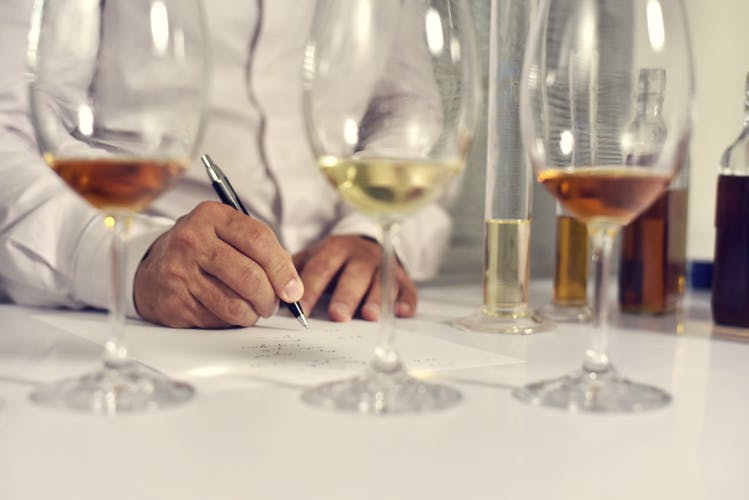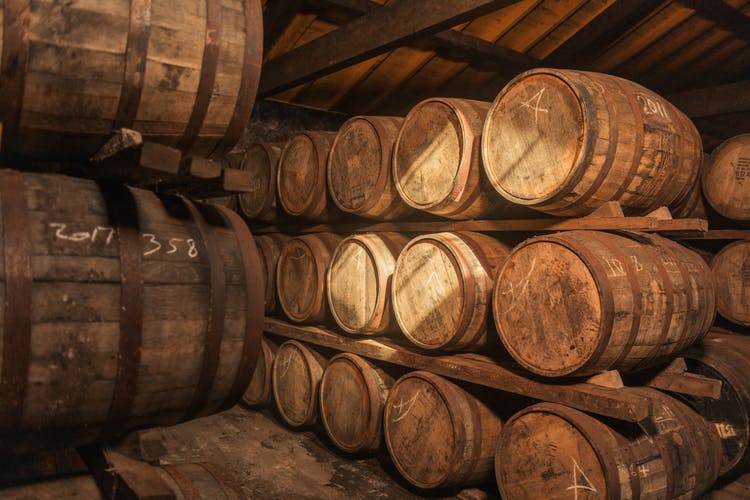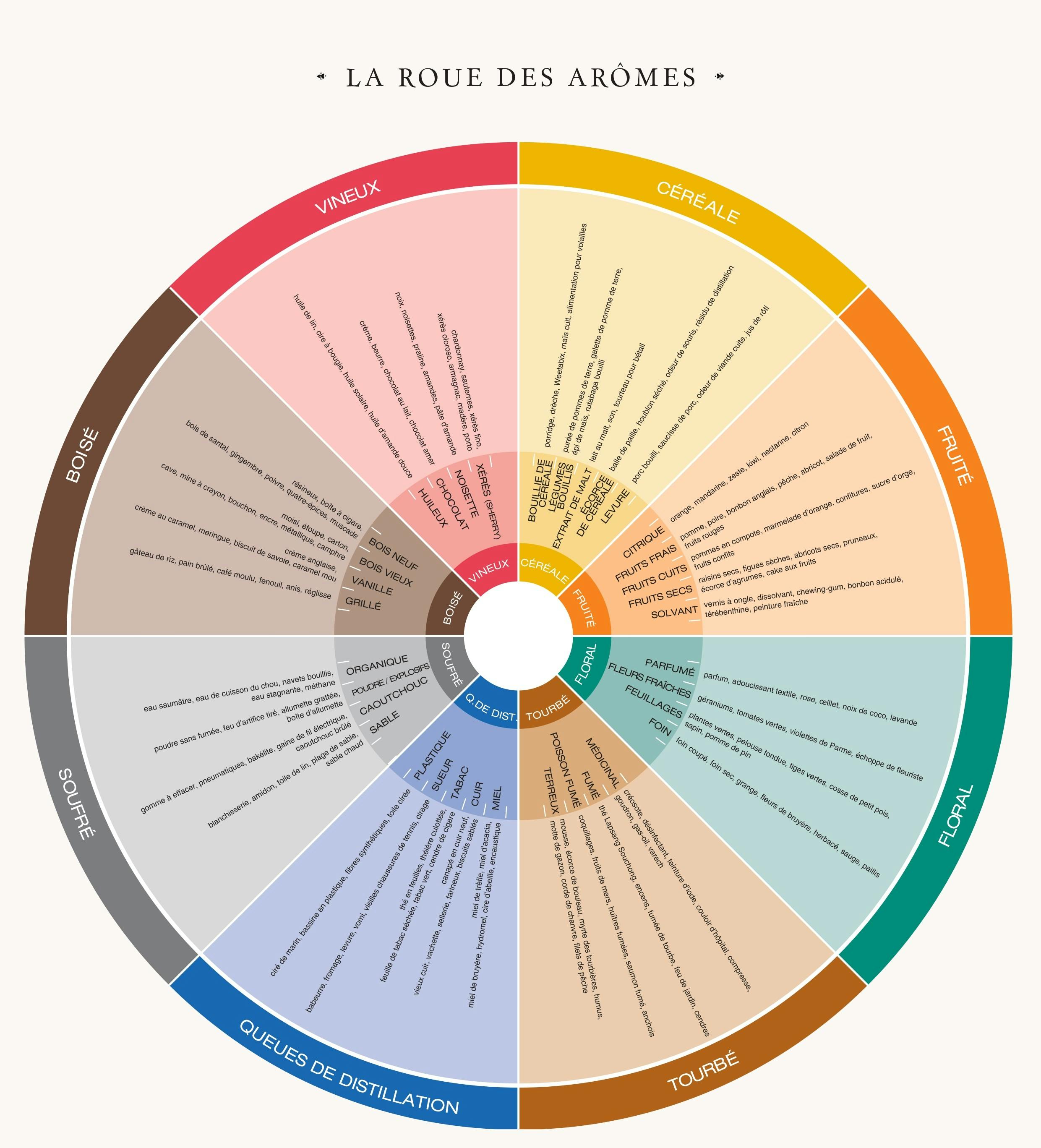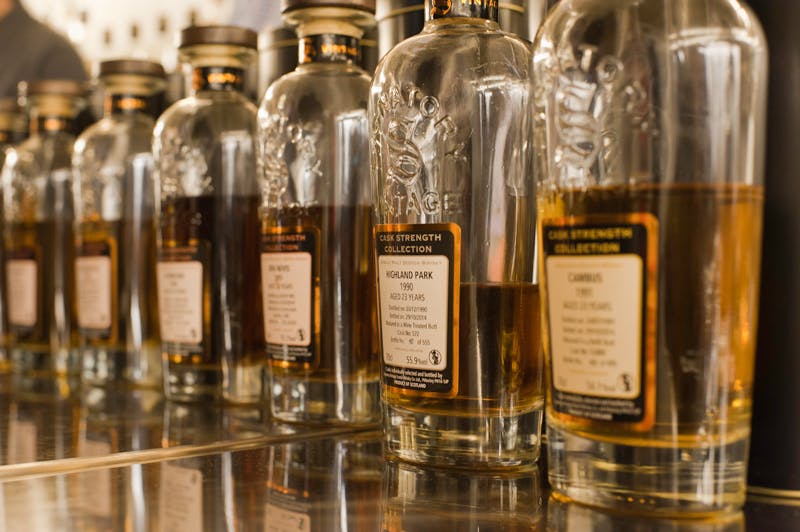
Le blending est un art qui ne se limite pas au whisky. D'autres spiritueux, vins, parfums, thés et cafés peuvent également être blendés. Cette pratique a vu le jour en Écosse au XIXe siècle, avec l'émergence des marchands de vins et spiritueux : John Walker de Kilmarnock (1820), George Ballantine d'Édimbourg (1827), William Teacher de Glasgow (1830), James Chivas d'Aberdeen (1839), John Dewar de Perth (1846). Ces « barons du whisky » étaient de véritables visionnaires, laissant une empreinte indélébile sur l'industrie et l'histoire du whisky, bien au-delà des frontières de l'Écosse.
Les différents types de blending
Les débuts
Représentant de Smith's of Glenlivet, Andrew Usher a lancé la première marque commerciale de whisky, Usher’s Old Vatted Glenlivet. Ce whisky était le résultat d'un blending (ou vatting) de plusieurs fûts d'âges différents provenant de la même distillerie (Glenlivet).
La pratique avait été reconnue auparavant dans une loi adoptée en 1853. Quelques années plus tard, le Spirit Act de Gladstone a permis de mélanger whiskies de grain et whiskies de malt dans des entrepôts, contribuant ainsi au succès des scotchs blended.
Blending et scotch blended
Les scotchs blended sont réalisés en mélangeant des single malts et des whiskies de grain. Ces derniers étaient à l'origine fabriqués à partir d'un mélange d'orge maltée et non maltée, distillée dans des alambics traditionnels. L'introduction en 1830 de l'alambic breveté, plus économique, a marqué un véritable tournant.
En 1846, l'abrogation des Corn Laws (qui limitaient l'utilisation de certaines céréales) a permis aux distillateurs de remplacer le mélange d'orge maltée/non maltée par un assemblage de grains moins coûteux contenant une forte proportion de maïs.
Ces facteurs, combinés à la crise du phylloxéra qui a ravagé les vignobles français à partir des années 1860, ont permis aux scotchs blended de s'imposer rapidement sur la scène internationale.
Blended malts et whiskies de grain blended
Une autre forme de blending consiste à assembler des single malts provenant de différentes distilleries.

Ces whiskies, connus sous le nom de blended malts (anciennement vatted malts ou pure malts), sont plus rares et essentiellement produits par de grandes maisons de blending qui proposent quelques versions : Johnnie Walker Green Label 15 ans, Famous Grouse Vintage 1987, Ballantine’s Pure Malt 12 ans, etc.
Cependant, ce style de whisky a également attiré l’attention d’une nouvelle génération de fabricants, comme John Glaser, fondateur de Compass Box, qui a développé des blended malts et blended grains, en mélangeant plusieurs whiskies de grain issus de petits lots (assemblages de plusieurs fûts).
Blending et single malts
La technique du blending est aussi utilisée pour produire des single malts, en assemblant des whiskies de différents âges au sein d'une même distillerie. L'âge du plus jeune whisky utilisé figure sur l'étiquette.

Cette pratique permet de gommer les écarts d’arômes et de saveurs qui peuvent exister entre différents fûts, et s'applique à la majorité des single malts disponibles sur le marché.
Les arômes dans le blending
Les master blenders
Aujourd’hui, les master blenders ne sont plus des commerçants indépendants inspirés du XIXe siècle, mais des professionnels employés par des maisons de blending.
Leur odorat est sollicité quotidiennement, et leur travail consiste non seulement à garantir la constance des blends existants, mais aussi à évaluer la qualité des nouveaux distillats produits par les distilleries de la maison.
Pour les aider dans cette tâche, ils utilisent un nouvel outil, le Cask Management, qui améliore la traçabilité des fûts (âge, origine).
Une symphonie d’arômes
Véritable chef d’orchestre, le master blender s’appuie sur une infinité d’arômes pour composer son chef-d’œuvre. Chaque composition est élaborée à partir d’une « partition » aromatique (une recette) qui sert de guide tout en laissant place à l’imagination.

Richard Paterson, maître assembleur de The Dalmore (©Scott Rankin Photography)
Le master blender commence par disposer ses « instruments », les whiskies, en fonction de leur profil aromatique et de leur complémentarité. Pour créer un thème central, il utilise les fragrances les plus intenses : arômes de fruits (agrumes), de fruits secs et de fleurs.

L’harmonie peut être enrichie par des notes plus vertes, herbacées ou épicées. Enfin, les percussions proviennent des arômes de tourbe, notamment les notes fumées et médicinales. Malgré l’identité forte de certains whiskies, la priorité du master blender reste de créer un ensemble harmonieux et complexe.
L’intensité d’un chef-d’œuvre
En plus de sélectionner une palette aromatique, le master blender détermine l’intensité avec laquelle chaque whisky contribue à l’harmonie finale.
Contrairement aux idées reçues, la proportion de whisky de grain n’influe pas autant sur la qualité que sur l’intensité du blend. En fin de compte, le choix des ingrédients et leur dosage précis sont les deux facteurs les plus importants.
Par exemple, un blend contenant une proportion significative de single malts tourbés, quelques single malts délicats et une faible proportion de whiskies de grain ne sera pas forcément complexe.
En général, le ratio de whiskies de malt par rapport aux whiskies de grain est d’environ 25/75, et le nombre de distilleries incluses peut varier entre vingt et cinquante. Cette diversité sert de filet de sécurité en cas de fermeture d'une distillerie.
Création d’un chef-d’œuvre
Une fois les whiskies sélectionnés et leurs proportions définies, le processus de blending peut commencer.
Certaines maisons préfèrent mélanger séparément leurs whiskies de malt et de grain, tandis que d’autres les versent tous dans une même cuve pour les laisser reposer avant dilution. À ce stade, l’alcool est ajusté à un niveau légèrement supérieur ou égal à la force d’embouteillage en ajoutant de l’eau déminéralisée.
Certaines maisons embouteillent le mélange après seulement quelques jours de « mariage ». Pour d’autres, cette étape est perçue comme essentielle pour harmoniser les arômes. Le whisky est alors transféré dans des fûts usagés, afin d’éviter toute influence du bois, pour une période de trois à six mois. Deux semaines avant l’embouteillage, les fûts sont vidés dans une grande cuve, où le whisky subit une dernière dilution pour atteindre le degré d’alcool souhaité.

Le rôle décisif des scotchs blended dans le développement d’une industrie du whisky moderne et durable est indéniable.
Des marques comme Ballantine’s, Chivas Regal, Dewar’s et Johnnie Walker ont apporté au scotch whisky son prestige, sa respectabilité et sa gloire. La technique du blending permet également de transcender le caractère spécifique de chaque distillerie, donnant naissance à des single malts aux palettes aromatiques plus expressives que jamais.
POUR ALLER PLUS LOIN DANS LA DÉCOUVERTE DES WHISKIES
La Maison du Whisky possède trois boutiques dans Paris :
Dans chacune de ces boutiques vous pourrez découvrir une vaste gamme de whiskies, rhums, sakés et autres spiritueux.
Parce qu’un whisky peut se décrire en mille mots, nos conseillers se feront un plaisir de vous faire découvrir les whiskies incontournables de La Maison du Whisky.
Suivez notre agenda de dégustation pour les dégustations à venir, ou rendez-vous au Golden Promise Whisky Bar qui propose un large choix de whiskies et autres spiritueux au verre.